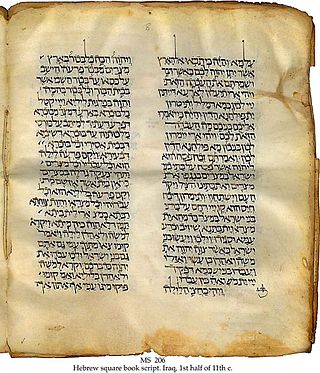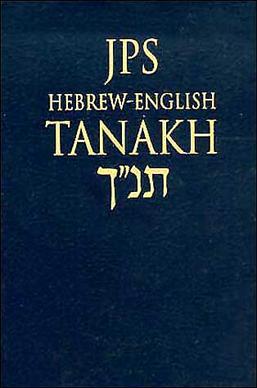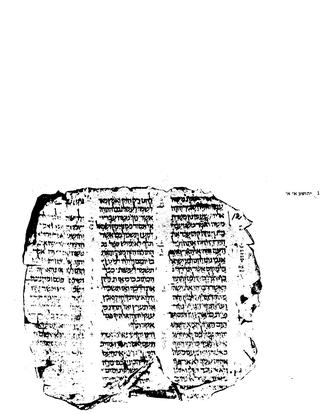
The Hebrew Bible or Tanakh, also known in Hebrew as Miqra, is the canonical collection of Hebrew scriptures, comprising the Torah, the Nevi'im, and the Ketuvim. Different branches of Judaism and Samaritanism have maintained different versions of the canon, including the 3rd-century BCE Septuagint text used in Second Temple Judaism, the Syriac Peshitta, the Samaritan Pentateuch, the Dead Sea Scrolls, and most recently the 10th-century medieval Masoretic Text compiled by the Masoretes, currently used in Rabbinic Judaism. The terms "Hebrew Bible" or "Hebrew Canon" are frequently confused with the Masoretic Text; however, this is a medieval version and one of several texts considered authoritative by different types of Judaism throughout history. The current edition of the Masoretic Text is mostly in Biblical Hebrew, with a few passages in Biblical Aramaic.

A targum was an originally spoken translation of the Hebrew Bible that a professional translator would give in the common language of the listeners when that was not Biblical Hebrew. This had become necessary near the end of the first century BC, as the common language was Aramaic and Hebrew was used for little more than schooling and worship. The translator frequently expanded his translation with paraphrases, explanations and examples, so it became a kind of sermon.

The Masoretic Text is the authoritative Hebrew and Aramaic text of the 24 books of the Hebrew Bible (Tanakh) in Rabbinic Judaism. The Masoretic Text defines the Jewish canon and its precise letter-text, with its vocalization and accentuation known as the mas'sora. Referring to the Masoretic Text, masorah specifically means the diacritic markings of the text of the Jewish scriptures and the concise marginal notes in manuscripts of the Tanakh which note textual details, usually about the precise spelling of words. It was primarily copied, edited, and distributed by a group of Jews known as the Masoretes between the 7th and 10th centuries of the Common Era (CE). The oldest known complete copy, the Leningrad Codex, dates from the early 11th century CE.
The Ketuvim is the third and final section of the Tanakh, after Torah ("instruction") and Nevi'im ("prophets"). In English translations of the Hebrew Bible, this section is usually titled "Writings" or "Hagiographa".

The New American Standard Bible is a translation of the Bible in contemporary English. Published by the Lockman Foundation, the complete NASB was released in 1971. New revisions were published in 1995 and 2020. The NASB relies on recently published critical editions of the original Hebrew, Aramaic, and Greek texts. It is known for preferring a literal translation style that generally preserves the structure of the original language when possible, rather than an idiomatic style that attempts to match natural English usage.

The Aleppo Codex is a medieval bound manuscript of the Hebrew Bible. The codex was written in the city of Tiberias in the tenth century CE under the rule of the Abbasid Caliphate, and was endorsed for its accuracy by Maimonides. Together with the Leningrad Codex, it contains the Aaron ben Moses ben Asher Masoretic Text tradition.

The Leningrad Codex is the oldest complete manuscript of the Hebrew Bible in Hebrew, using the Masoretic Text and Tiberian vocalization. According to its colophon, it was made in Cairo in AD 1008.

A Mikraot Gedolot, often called a "Rabbinic Bible" in English, is an edition of the Hebrew Bible that generally includes three distinct elements:

The New Jewish Publication Society of America Tanakh, first published in complete form in 1985, is a modern Jewish 'written from scratch' translation of the Masoretic Text of the Hebrew Bible into English. It is based on revised editions of earlier publications of subdivisions of the Tanakh such as the Torah and Five Megillot which were originally published from 1969 to 1982. It is unrelated to the original JPS Tanakh translation, which was based on the Revised Version and American Standard Version but emended to more strictly follow the Masoretic Text, beyond both translations being published by the Jewish Publication Society of America.

The Biblia Hebraica Quinta Editione, abbreviated as BHQ or rarely BH5, is the fifth edition of the Biblia Hebraica. When completed, it will supersede the fourth edition, the Biblia Hebraica Stuttgartensia (BHS/ BH4).

The Codex Cairensis is a Hebrew manuscript containing the complete text of the Hebrew Bible's Nevi'im (Prophets). It has traditionally been described as "the oldest dated Hebrew Codex of the Bible which has come down to us", but modern research seems to indicate an 11th-century date rather than the 895 CE date written into its colophon. It contains the books of the Former Prophets and Latter Prophets. It comprises 575 pages including 13 carpet pages.
Ashrei is a prayer that is recited at least three times daily in Jewish prayers, twice during Shacharit and once during Mincha. The prayer is composed primarily of Psalm 145 in its entirety, with Psalms 84:5 and Psalms 144:15 added to the beginning, and Psalms 115:18 added to the end. The first two verses that are added both start with the Hebrew word ashrei, hence the prayer's name.
The Hebrew University Bible Project (HUBP) is a project at the Hebrew University of Jerusalem to create the first edition of the Hebrew Bible that reproduces the text of the Aleppo Codex and includes a thorough critical apparatus.
The Jerusalem Crown is a printed edition of the Tanakh printed in Jerusalem in 2001, and based on a manuscript commonly known as the Aleppo Crown). The printed text consists of 874 pages of the Hebrew Bible, two pages setting forth both appearances of the Ten Commandments each showing the two different cantillations—for private and for public recitation, 23 pages briefly describing the research background and listing alternative readings, a page of the blessings—the Ashkenazic, Sephardic and Yemenite versions—used before and after reading the Haftarah, a 9-page list of the annual schedule of the Haftarot readings according to the three traditions.
Biblia Hebraica may refer to:
A seder is part of a biblical book in the Masoretic Text of the Hebrew Bible.
The Literal English Version of Scripture (LEV) is a translation of the Bible based on the World English Bible. Formerly known as the "Shem Qadosh Version", the title was officially changed in November 2016. It is considered a Sacred Name Bible rendering the name of God using the Hebrew characters יהוה, and that of Jesus in Hebrew as ישוע. It was created by a team of volunteers across the United States with additional proofing and editing assistance by individuals in Poland and Taiwan. Footnotes and appendices were written by the General Editor, J. A. Brown.
Gérard Emmanuel Weil was a French Hebraist and biblical scholar.

The Damascus Pentateuch or Codex Sassoon 507 is a 10th-century Hebrew Bible codex, consisting of the almost complete Pentateuch, the Five Books of Moses. The codex was copied by an unknown scribe, replete with Masoretic annotations. The beginning of the manuscript is damaged: it starts with Genesis 9:26, and Exodus 18:1–23 is also missing. In 1975 it was acquired by the Jewish National and University Library, Jerusalem. The codex was published in a large, two-volume facsimile edition in 1978.
Puncta extraordinaria, or extraordinary points, refer to certain small dots in the Masoretic Text of the Hebrew Bible, where they appear alongside other, more common, traditional markings (nequddot) found in the Masoretic Text. There are fifteen places in the Masoretic Text where the puncta extraordinaria appear. Ten of the fifteen instances are in the Pentateuch. The dots may appear above or below individual letters or even an entire word or group of words.












